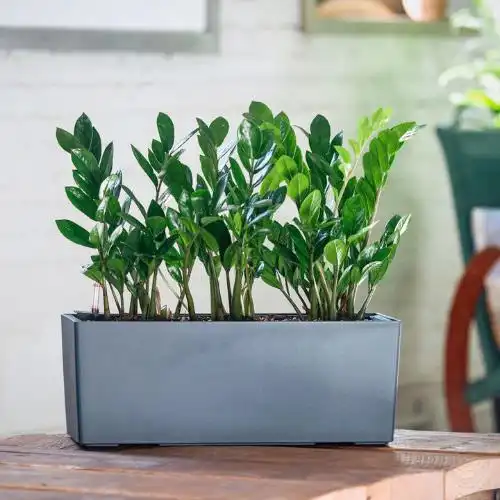Welcome to the ultimate guide on ZZ plant care, crafted by me, Juliette, a seasoned plant expert and owner of an online indoor plant shop and plant maintenance company in New York City.
With over a decade of experience, my team and I have honed our expertise by nurturing thousands of indoor plants, making us well-versed in the nuances of urban plant care.
I have crafted this guide based on our own journey with the resilient and graceful ZZ plant, a beloved choice for homes and offices alike due to its eye-catching beauty and easy maintenance needs.
Here, you won’t find just basic care tips; this guide is a comprehensive resource developed through years of professional practice and a deep passion for plant life.
Whether you’re a beginner looking for simple watering advice or a seasoned plant owner in search of advanced pest control techniques, this guide has everything you need to ensure your ZZ plant thrives.
Become part of our vibrant community of plant enthusiasts and experts by embracing this guide as your ultimate go-to source for everything related to ZZ plant care.
Types of ZZ plants
The ZZ plant, or Zamioculcas zamiifolia, is a gem among houseplants. It is hailed for its ability to thrive under minimal care. Native to Eastern Africa, this plant has made a name for itself in the indoor plant community. It attracts admirers with its glossy, emerald leaves and robust nature.

ZZ plants, or Zamioculcas zamiifolia, come in several attractive varieties. Here’s a brief overview of some of the distinct types I’ve come across:
- Zamioculcas Zamiifolia: aka original ZZ plant or aroid palm, is characterized by its stemless growth habit. It typically reaches a height of 3 feet, showcasing striking, pinnately compound leaves that emerge from its rhizomes.
- Zamioculcas Zamiifolia ‘Zenzi’: the dwarf variety of the ZZ Plant, known for its dense, curled leaves that give it a lush, bushy appearance, along with a more compact growth habit. Typically, it will not exceed a height of about 10-12 inches.
- Zamioculcas Zamiifolia ‘Raven’: aka Black ZZ, a slower-growing variation of the ZZ Plant. This variety is popular for its deep, dark foliage that is slightly smaller in size. Given adequate time and the appropriate environment, it can reach a maximum height of about 2.5 feet. This distinctive feature adds a dramatic flair to indoor spaces.
Benefits of having a ZZ plant
ZZ plant care is remarkably straightforward. Its tolerance for a range of lighting conditions and infrequent watering are qualities that contribute to its reputation as a nearly indestructible plant. With my experience, I can attest to the ease with which this plant integrates into different living spaces. It requires little from its caretaker while providing a lush ambiance of greenery.

Having a ZZ plant (Zamioculcas zamiifolia) in your home has numerous advantages.
Here are a few benefits of having ZZ plants in your space:
- Air Purification: Removes VOCs, contributing to better air quality.
- Low Maintenance: With minimal care requirements, the ZZ plant remains effortlessly attractive, providing long-lasting beauty without demanding extensive upkeep.
- Aesthetic Enhancement: Glossy leaves and their unique structure create a striking silhouette, enhancing visual interest and adding dimension to indoor environments.
- Positive Psychological Impact: Adds a calming element to the environment, potentially improving cognitive functions.
How to buy ZZ plants
When searching for a ZZ plant, you will find options in terms of plant size, variety, and where to purchase, such as local nurseries and plant shops, online retailers, or gardening centers.
Finding a ZZ plant is a breeze, thanks to its popularity as a low-maintenance and resilient houseplant.
I do not recommend buying plants from department stores like Home Depot, as most of the time, plants are not stored and cared for properly, resulting in root and pest issues.
Buying Tips:
Choosing a healthy plant is key to thriving indoor greenery. Whether you’re a seasoned green thumb or a beginner, knowing how to choose a healthy and thriving ZZ plant ensures a strong start to your green journey.
Here are some quick tips to help you choose the perfect one!
- Check the leaves: Look for vibrant, glossy leaves without yellowing or browning edges.
- Inspect the stems: They should be firm and upright, not limp or drooping.
- Examine the roots: Healthy roots are white or light-colored, not dark or mushy.
- Check for pests: Look for signs of pests like aphids, spider mites, scale or mealybugs, which can indicate poor plant health.
- Consider the pot: Ensure the pot has drainage holes and isn’t too small for the plant’s size.
- When buying plants online, only purchase from reputable sources. Check the reviews to see if others are happy with their plants.
ZZ Plant Care: Environment
When I introduce ZZ plants to any space, I ensure the environment is tailored to their specific needs in lighting, temperature, humidity, and placement. Understanding how to care for ZZ plants by getting these conditions right will ensure the health and growth of these hardy plants.
ZZ plants flourish in bright, indirect light but are also quite adaptable to low-light conditions, making them suitable for spaces with less natural sunlight.
They prefer stable indoor climates without extreme temperature changes or drafts and do best in average indoor humidity, although they can adjust to different levels of moisture in the air.
ZZ Plant Care: Light

ZZ plants flourish in environments with bright, indirect light. I’ve found that exposing these plants to direct sunlight for too long can be a bit harsh, possibly resulting in scorched leaves. However, they seem to really enjoy soaking up the gentle morning sun for an hour or two.
When I use ZZ plants in low-light settings, like an office with fluorescent lighting, they tend to do surprisingly well. Though their growth might not be as robust as those in brighter spots, ZZ plants still manage to thrive and maintain their vitality.
ZZ Plant Care: Temperature
From what I’ve seen, ZZ plants do best indoors when the temperature is kept between 60-75°F (15-24°C).
They can tolerate a bit higher or lower temperatures, but dramatic fluctuations or drafts can cause stress to these plants.
Therefore, when focusing on ZZ plant care, it is important to avoid placing ZZ plants near heating or cooling vents to ensure they remain healthy and stress-free.
ZZ Plant Care: Humidity
Although ZZ plants can adapt to a broad range of humidity levels, they prefer average indoor humidity.
I’ve found that keeping the humidity level between 40% and 60% is optimal for ZZ plants to thrive.
While it’s not mandatory, adding a humidifier to the room can offer extra comfort, especially if the air tends to be particularly dry.
ZZ Plant Care: Placement
When choosing a spot for a ZZ plant inside homes or offices, I seek an area that meets the light and temperature criteria previously mentioned, which are vital aspects of effective ZZ plant care.
It should be placed away from children and pets, as the plant can be toxic if ingested.

Ideally, the plant should be positioned in a spot where its arching stems have ample space to spread out without becoming crowded. This not only enhances its aesthetic beauty but also promotes unhindered growth.
ZZ Plant Care: Re-potting
Proper planting and selecting the right soil are important to the health and growth of ZZ plants.
When to repot ZZ plants
I typically repot my ZZ plants every 2-3 years. Signs indicating it’s time for a new pot include roots crowding the current one or growing through the drainage holes.
Additionally, if the soil dries out faster than usual, prompting more frequent watering, it’s a good indicator that the plant may benefit from a larger container.
Best soil for ZZ plants
A well-draining potting mix is key to ZZ plant health.
I often use cactus and succulent soil for my ZZ plants.
To increase the porosity of the soil, I like to incorporate perlite or coarse sand into the mix.
The goal is to ensure that the soil retains moisture while remaining loose enough for excess water to drain, preventing root rot.
Best planters for ZZ plants
When it comes to ZZ plant care, choosing the right planter is crucial.
Planters with drainage holes are essential for ZZ plants.
I recommend using terracotta or unglazed ceramic planters because they’re porous, allowing for better soil drying.
Additionally, self-watering planters like Lechuza, one of my favorites, are great for all my plants. These pots feature drainage and a sub-irrigation system that significantly reduces watering frequency while giving the plant control over water intake.
Ensure that the planter is just one size larger than the current one to avoid water retention issues. This helps prevent overwatering, which can lead to root rot, ensuring the plant remains healthy and thrives.
ZZ plant repotting guidelines
- Choose a pot with drainage holes to prevent waterlogging.
- Gently remove the ZZ plant from its current pot and inspect the roots, trimming any that are dead or rotting.
- Prepare the new pot by placing a layer of new potting mix at the bottom.
- Set the plant in and add more soil mix around it, pressing down lightly to eliminate air pockets but without compacting the soil too much.
- Best to use dry or slightly moist soil for ZZ plant repotting.
- Water the ZZ plant thoroughly after repotting to help it settle in its new home.
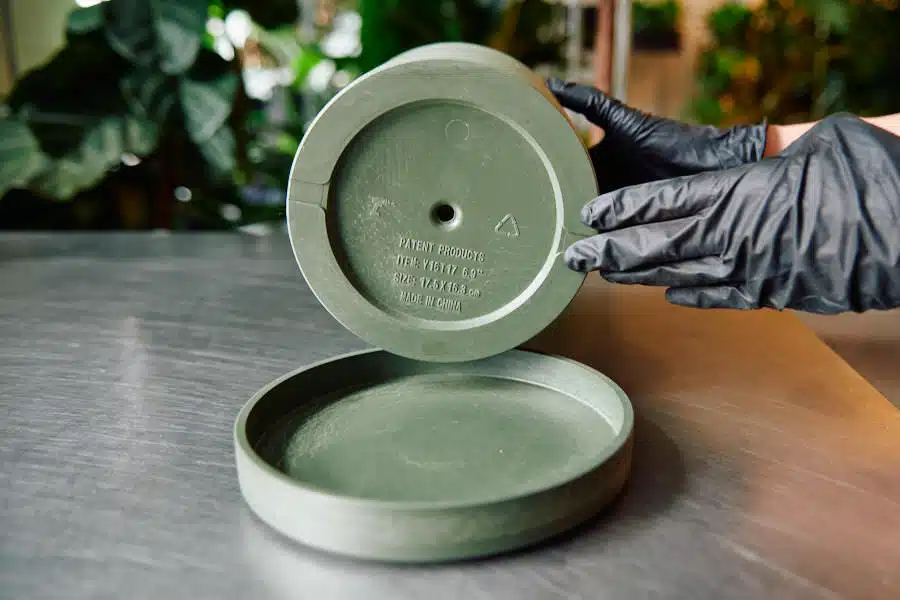
© My City Plants
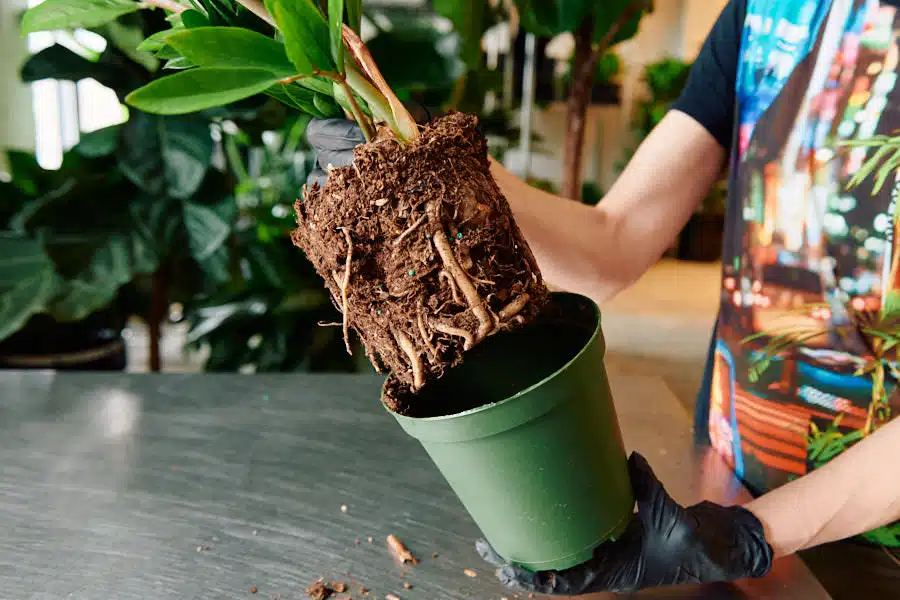
© My City Plants
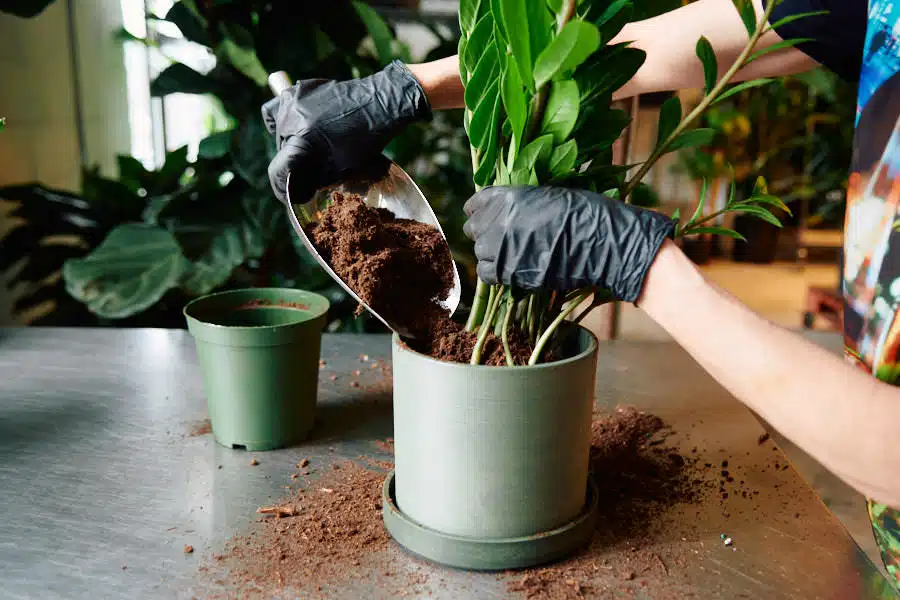
© My City Plants
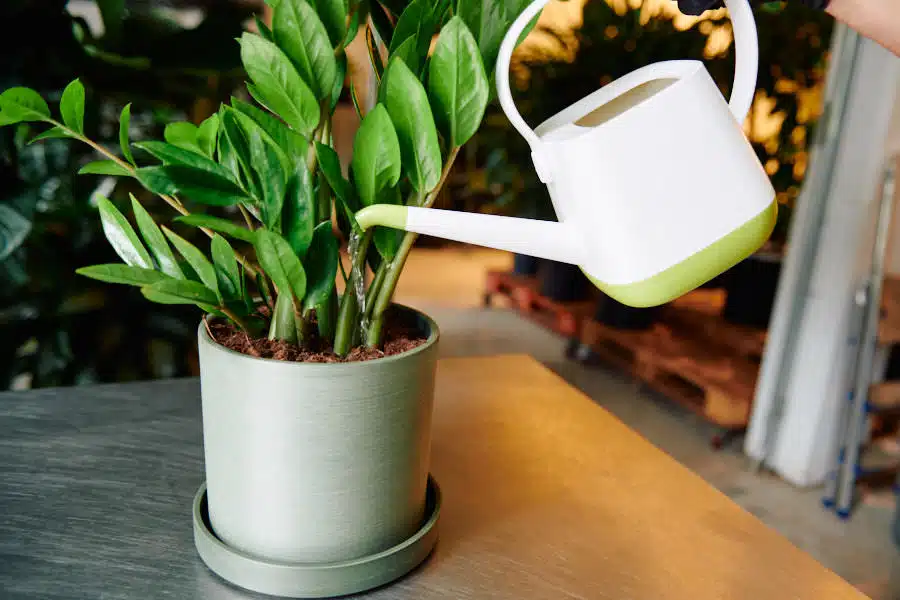
© My City Plants
ZZ Plant Care: Watering
When watering ZZ plants, precision is key to keeping them healthy. Many problems with ZZ plants arise from over-watering. While these plants are famous for their low watering requirements and can tolerate some neglect, it’s important to avoid under-watering them as well.
When watering my ZZ plant, I ensure the soil is dry all the way through.
ZZ plant watering methods
Top watering method
- Water evenly: Pour water evenly over the soil surface until it starts to drain out from the bottom drainage holes. Ensure that the water reaches all parts of the soil.
- Allow drainage: Allow excess water to drain freely from the pot into a saucer or sink. Let the pot sit for a few minutes to ensure thorough drainage.
- Empty saucer: After watering, empty any excess water from the saucer to prevent the plant from sitting in standing water.
Bottom watering method:
Fill container: Fill a shallow container. Make sure the container is large enough to accommodate the plant’s pot.
- Place pot in water: Set the plant’s pot into a container of water, allowing the water to seep up through the drainage holes into the soil.
- Let soil absorb water: Allow the soil to absorb water from the bottom for about 10-20 minutes or until the top layer of soil appears moist.
- Remove pot: Once the soil has absorbed enough water, remove the pot from the container of water and let any excess water drain out.
Add water to saucer: When using a saucer, you might need to add water a few times.
- Fill up saucer: Add water to the saucer.
- Let soil absorb water: Allow the soil to absorb water from the bottom for about 10-20 minutes. If all the water is absorbed, add more water.
During the first round or two, the plant will quickly absorb water if the soil was dry enough. As the soil becomes saturated, the absorption slows down.
Repeat the process until the plant is no longer taking in water. Once you’ve reached the point where the water is no longer absorbed, wait for an hour or two. If the water is still standing in the saucer at that point, the plant has had enough and the extra water can be removed.
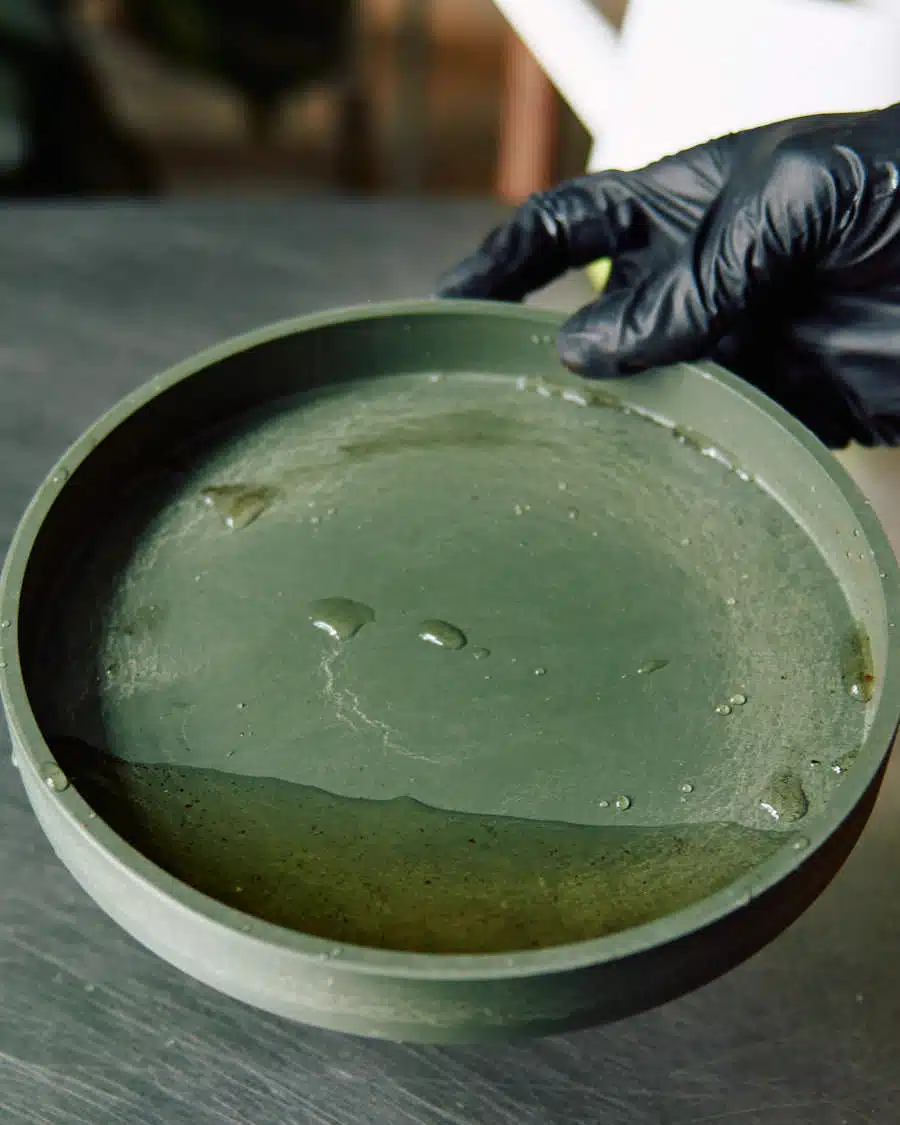
- Empty saucer: Empty any remaining water from the saucer to prevent the plant from sitting in standing water.
ZZ plant watering frequency
I do not water my ZZ plants on a strict watering schedule.
Instead, I check the soil every 7-10 days, and when it’s dry all the way through, I water my plants.
Overwatering prevention
To prevent ZZ plant overwatering, I practice the following steps:
- Drainage: Use pots with drainage holes to avoid water accumulation.
- Excess water: Remove any excess water from the saucer.
- Observation: Keep an eye on the leaves; yellowing and browning may indicate too much water.
- Soil test: Establish a soil testing schedule and always test the soil before watering.
By maintaining proper watering practices, I protect my ZZ plant from common issues related to improper moisture levels.
How to test the soil before watering
- insert your finger into the soil as deeply as possible.
- If it’s difficult due to bulky roots, try testing through the drainage hole.
I use and strongly recommend using a soil moisture meter for more accurate readings.

- Insert the meter in a few spots around the plant, ensuring it goes deep without hitting the pot bottom.
- When the meter reading is in zone 1, I wait an additional week for small plants and two weeks for larger plants before watering.
How to water ZZ plants in Lechuza self-watering planters
Lechuza planters feature a built-in water reservoir that reduces the frequency of watering. Simply wait for the indicator to signal that the reservoir is empty, then test the soil moisture level, if the soil is dry, refill it up to the maximum mark.
This self-watering setup maintains a steady level of moisture, ideal for ZZ plants.
To learn more about how to water plants in Lechuza planters watch my video.
Watch my video about how to water plants in Lechuza planters to learn more.
How to water ZZ plants in planters with drainage
To water a ZZ plant in a pot with drainage, first, check the soil. The soil should be completely dry all the way through before watering. If it’s dry, pour water slowly around the plant and between its stems until you see water coming out of the bottom. Let the excess water drain out completely. Remove any extra water from the saucer under the pot to prevent root rot.
Typically, ZZ plants need watering every 2-4 weeks, depending on factors such as plant size, lighting, and temperature conditions.
Test the soil every 2 weeks and adjust watering frequency based on how quickly the soil dries.
I use and strongly recommend using a soil moisture meter for more accurate readings.
How to water ZZ plants in cache pots
If your plant is dropped into the cachepot, take the ZZ plant out for watering. Water the plants well and let any excess water drain completely before returning it to the pot. This method prevents water from accumulating at the bottom, which could cause root rot.
If your ZZ plant is potted directly in a cachepot (which is not ideal) and cannot be removed for watering, it’s crucial to water it sparingly to avoid waterlogging. Be mindful not to use too much water since there are no drainage holes.
Using a soil moisture meter can be helpful to avoid overwatering your ZZ plant.
Watch my video to learn how to check the soil after watering to ensure the plant receives adequate moisture.
Always check the soil before watering!
How to water ZZ plants in nursery pots
Begin by checking the soil to ensure it’s very dry and the plant is ready for watering. When watering ZZ plants in nursery pots, apply water slowly and evenly across the soil until you see it draining from the bottom of the pot.
Avoid letting the plant stand in water to prevent waterlogged soil, which can lead to root rot.
Observe how the plant responds to watering to fine-tune your watering schedule and amount, adjusting based on how quickly the soil dries out.
ZZ Plant Care: Fertilization
In my care routine for ZZ plants, I make sure they get just the right amount of nutrients to keep their foliage lush and growth healthy. Being careful with feeding is important because these plants don’t like too much fertilizer.
When to fertilize ZZ plants
I’ve found that sticking to a regular feeding schedule works best. For those wondering how to fertilize plants, during the growing season, like Spring and Summer, I feed my ZZ plants with every other watering. During the Fall and Winter months, I usually take a break from feeding altogether, letting the plant take it easy and rest.
I also dilute the liquid fertilizer to half-strength to prevent potential damage to the plant’s root system and leaves from excessive nutrients.
Best fertilizer for ZZ plants
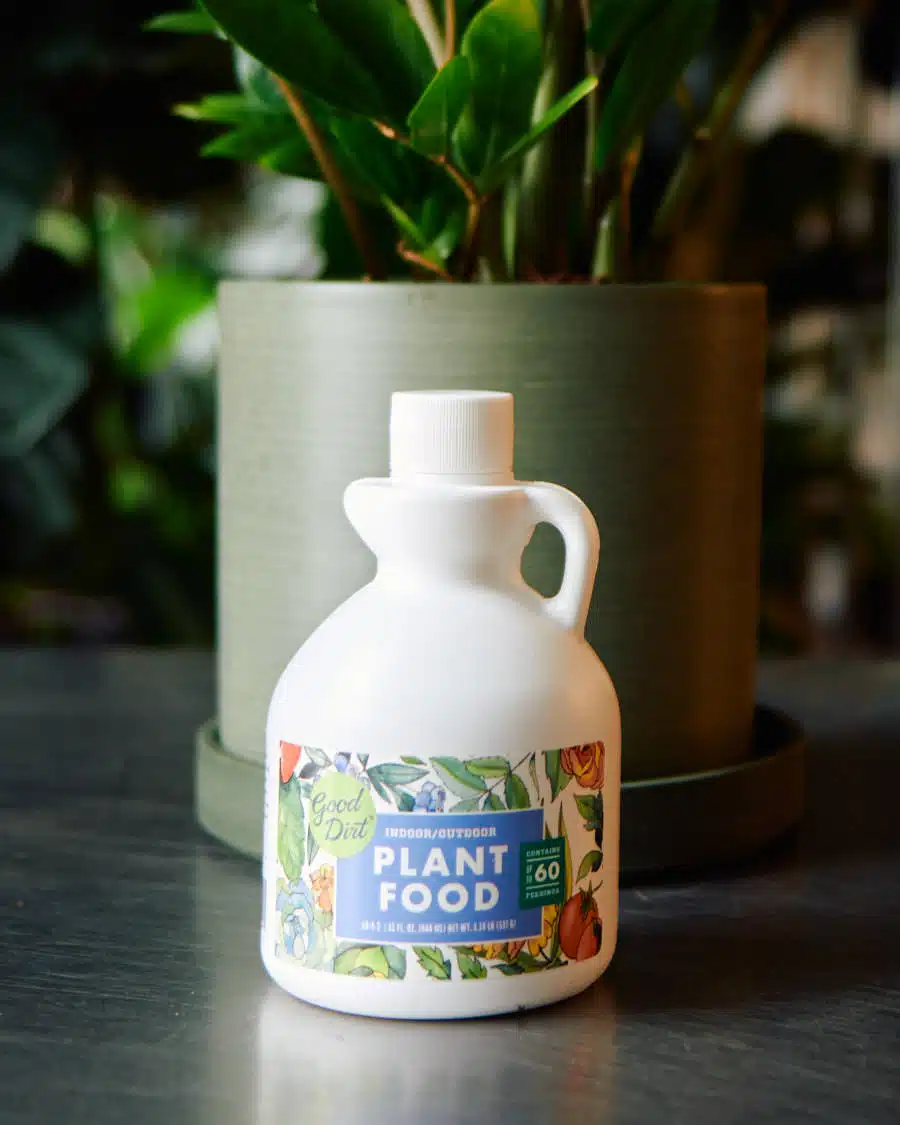
The plant food I use and my ZZ plants love it is Good Dirt Fertilizer. The gentle formula of this plant food can be used each time you water your ZZ plants.
Follow the ratio instructions on the label.
ZZ Plant Care: Growth Expectations
ZZ plants are known for their slow but steady growth, particularly when cultivated indoors.
I observe that with proper care, it typically shows a great growth rate and a long lifespan.
Generally, indoor ZZ plants can reach heights ranging from 1 to 3 feet (30 to 90 centimeters) over several years of growth. However, some well-established specimens may grow even taller under optimal conditions.
Under proper ZZ plant care, the robust growth rate and enduring vitality of ZZ plants become evident. Maturation from a young plant typically spans 3 to 5 years, with the plant generating 3 to 6 new stems annually and expanding in diameter yearly.
ZZ plants demonstrate remarkable resilience, thriving for over 10 years under ideal conditions. Some ZZ plants exceed this timeframe, although I’ve observed that with average care, they typically persist for around 5 years.
ZZ Plant Care: Propagation
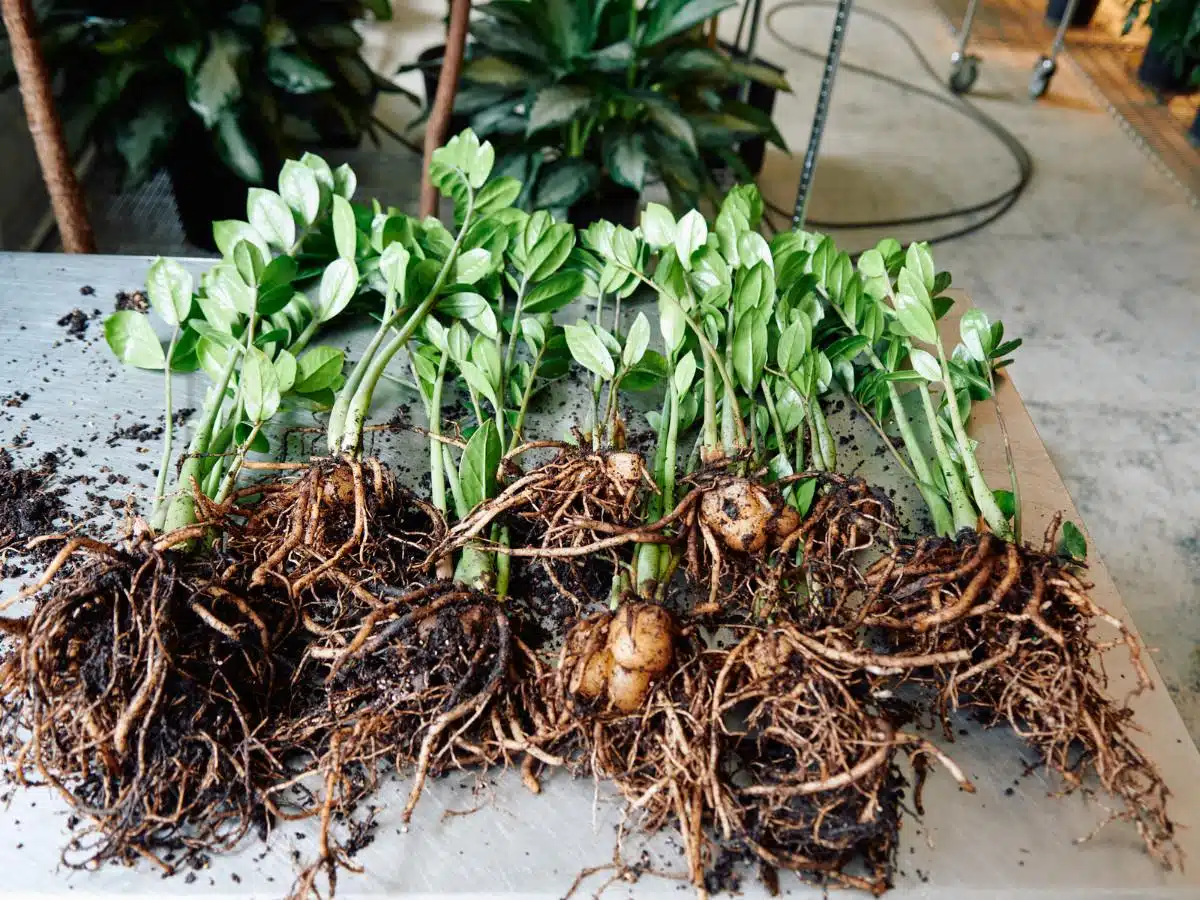
ZZ plants can be propagated using three simple methods: division, water, and soil.
- Division Method: Quickly and easily create multiple smaller plants by separating the rhizomes of a healthy ZZ plant. These are then replanted and kept in well-draining soil with bright, indirect light.
- Stem and Leaf Propagation in Water: Involves cutting stems or leaves and placing them in water to root. This method allows for easy monitoring of root growth. Once roots develop, the cuttings are ready to be potted.
- Stem and Leaf Propagation in Soil: A slower process where stem or leaf cuttings are prepared and planted in soil. This method requires patience as roots take several months to develop. The soil should be kept slightly damp and the pot placed in a warm area with indirect sunlight.
For a deeper dive into each method and detailed steps on how to propagate ZZ plants effectively, check out my comprehensive post “How To Propagate ZZ Plants”. Whether you’re a beginner or an experienced gardener, you’ll find valuable tips to expand your plant collection.
ZZ Plant Care: Cleaning
Making sure my ZZ plant’s leaves stay dust-free isn’t just about appearances—it also helps the plant photosynthesize better. When considering how to clean ZZ plant leaves, I find using a Swiffer regularly is a gentle yet effective way to remove dust.
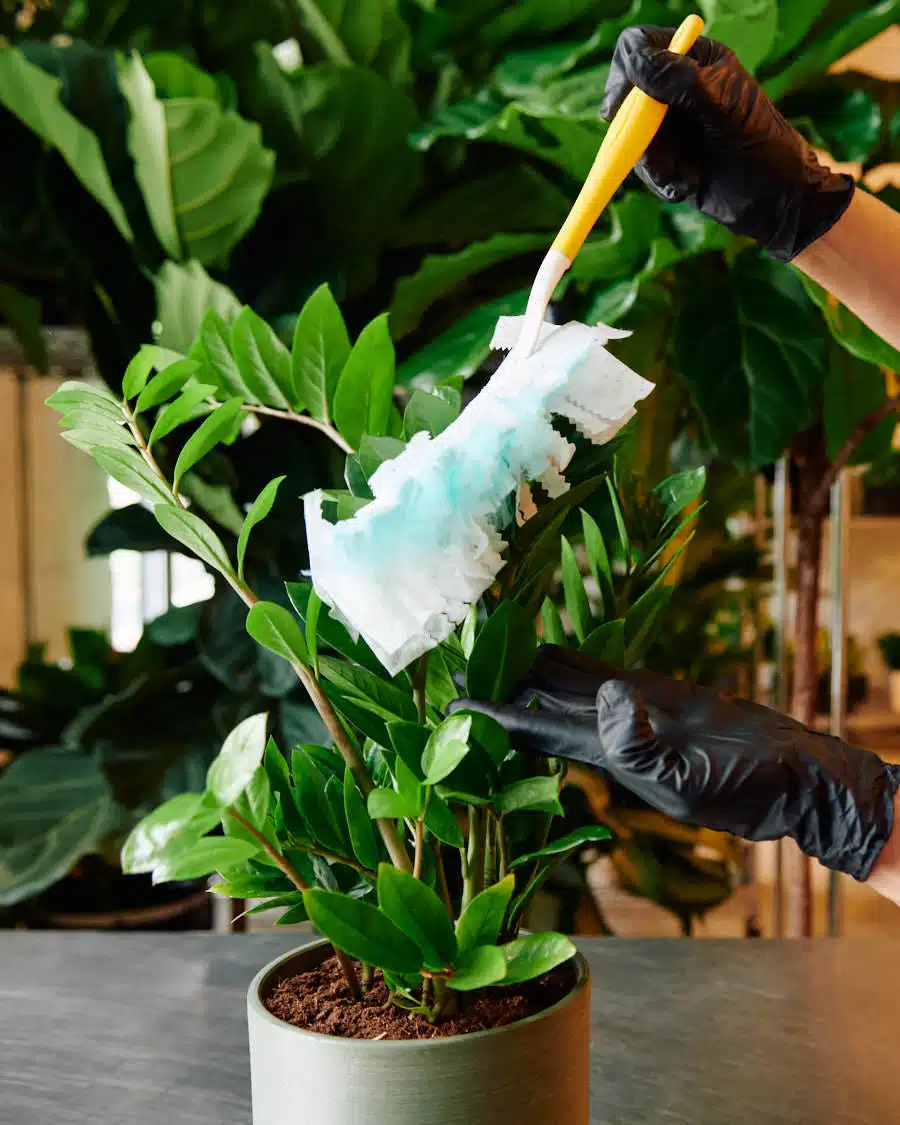
For a deeper clean, I opt for a soft cloth dampened with lukewarm water to gently wipe each leaf and clean the pot.
For the best results, aim to give your plants a thorough cleaning every month or every other month. This routine not only keeps your plants looking their best but also promotes their overall health and helps prevent any potential pest issues.
ZZ Plant Care: Trimming
Learning how to trim a ZZ plant is an essential part of caring for these lovely plants, ensuring they stay free from any brown or yellowing leaves that might pop up.
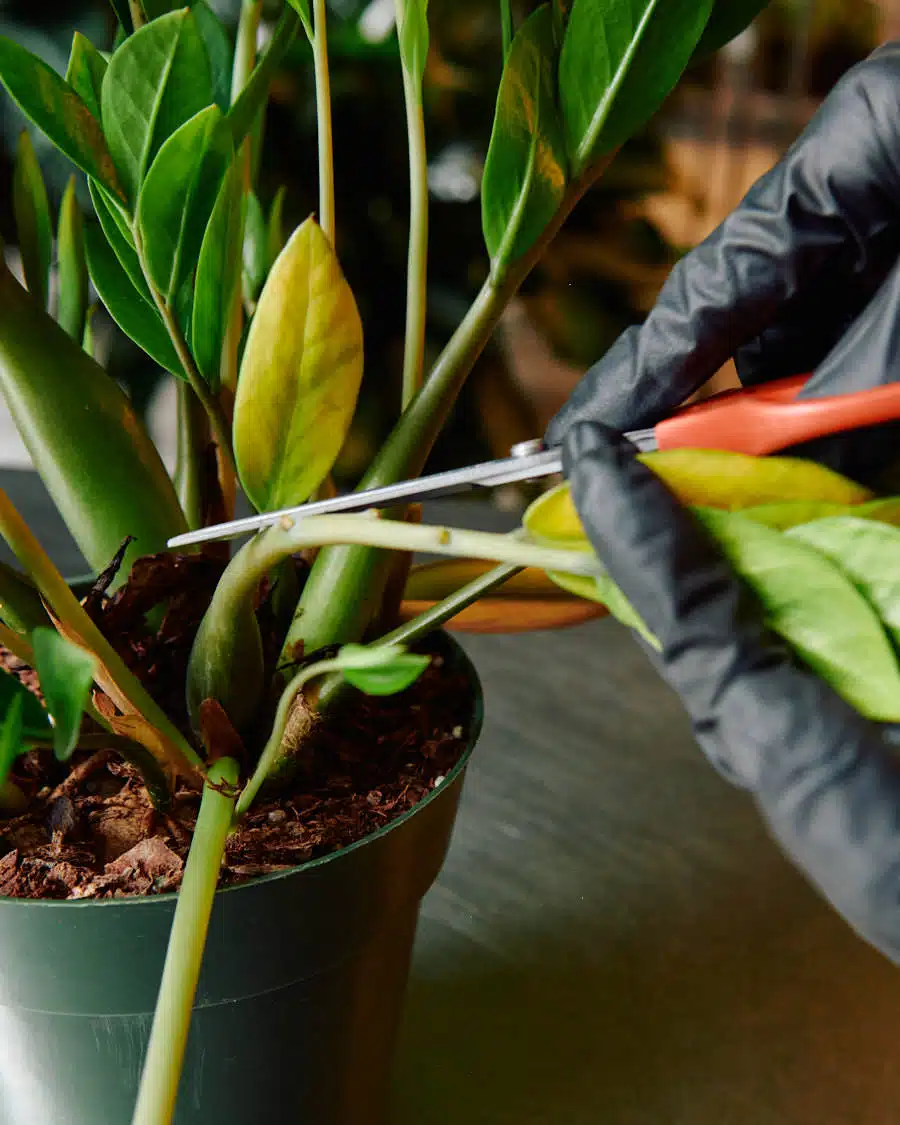
By removing these leaves, not only do you keep your plant looking its best, but you also stop any potential diseases in their tracks and encourage fresh growth. Plus, you’re saving valuable nutrients and energy that would otherwise be wasted on those dying leaves.
I use clean, sharp scissors to snip the leaves at their base without harming the stem.
ZZ Plant Care: Rotation
Rotating your ZZ plant is like giving it a little nudge in the right direction!
Since these plants love to lean towards the light, I give them a turn each time I water them to ensure they grow nice and evenly, to prevent them from getting lopsided. My plants thank me with a beautiful and balanced appearance!
ZZ Plant Care: Pruning
Pruning helps maintain a desirable shape and encourages fuller growth.
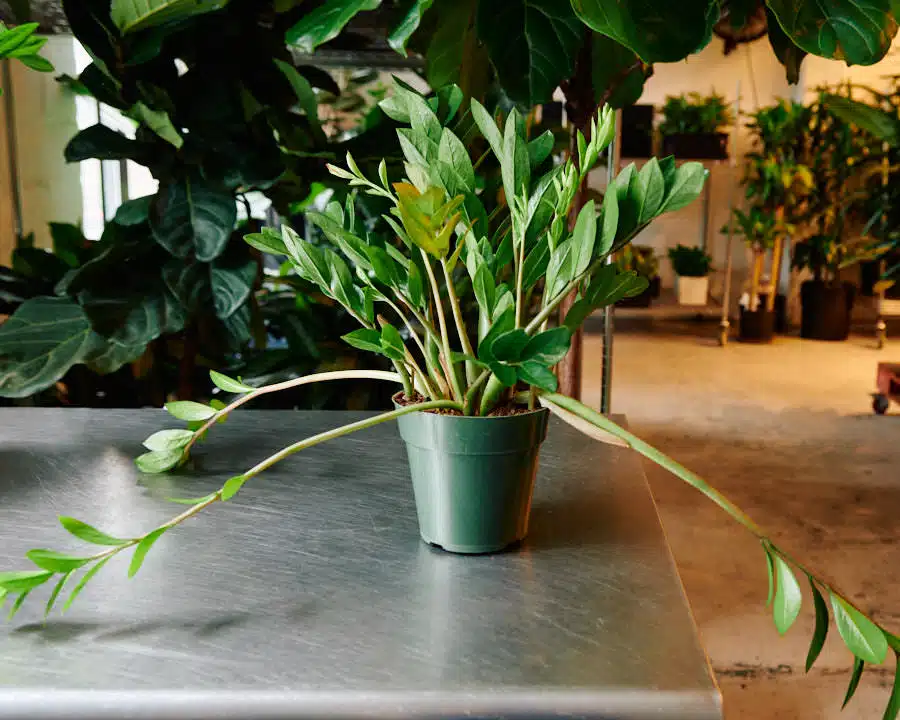
When explaining how to prune ZZ plants, I advise looking for any leggy or overgrown stems.
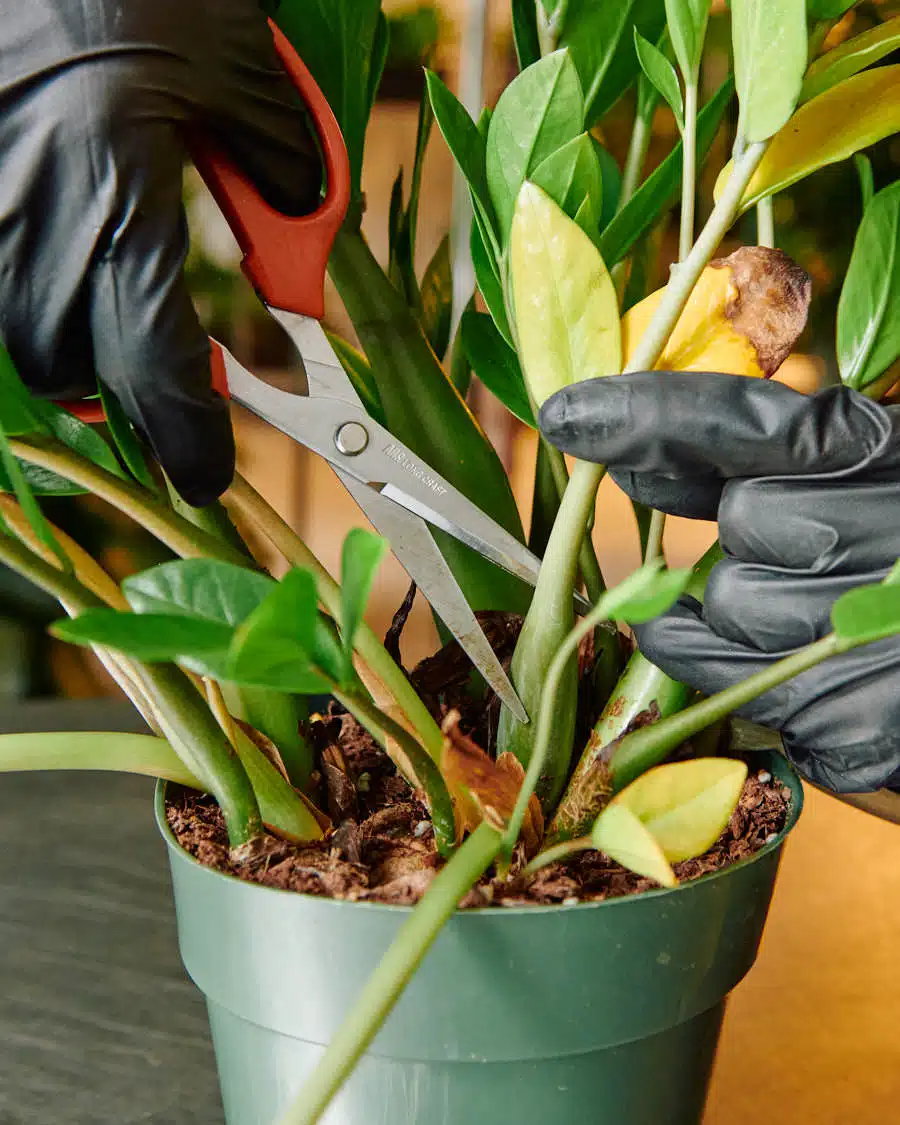
Using clean and sharp pruning shears, cut these stems back at the soil level. This technique encourages the plant to branch out, resulting in a denser and more attractive appearance.
ZZ Plant Care: Pests
Pests like spider mites, scale, aphids, gnats, and mealybugs can be real troublemakers for ZZ plants. But don’t worry, there are effective solutions!
At the first hint of spider mites, scale, and mealybugs infestation, I reach for insecticidal soap or neem oil. These treatments work wonders for getting rid of those pesky bugs and preventing the spread.
When I catch aphids having fun in my ZZ plants, I treat them immediately with insecticidal soap, which suffocates and kills them on contact. Additionally, you can physically remove them by spraying them off with a strong stream of water or wiping them away with a cloth.
I apply treatments once a week until the issue is resolved.
Dealing with mild or heavy spider mites, scale, and mealybugs infestation requires some extra TLC.
First, I carefully remove any heavily infested stems and leaves to stop the pests from spreading.
For mild infestations, I meticulously wipe down the affected areas with a soft cloth dipped in soapy water to eliminate visible pests.
But for heavy infestations, it’s time to bring out the big guns. I mix up a potent alcohol solution using 1 cup (8oz) of 70% rubbing alcohol, 30 oz of water, and a few drops of mild dish soap.
I generously spray my plants, ensuring every leaf, stem, and even the topsoil is thoroughly covered.
Next, I lightly spray my plants with Neem oil. It’s crucial to repeat this treatment weekly until there are no signs of pests left.
After the pests are gone, I continue to lightly spray Neem oil once every 2-3 weeks for the next couple of months to prevent their return.
Consistency is key to completely eradicating the infestation and keeping your ZZ plant healthy and pest-free. With dedication and regular care, you’ll have your plant thriving in no time!
Common pests
- Spider Mites: Tiny arachnids that commonly infest indoor and outdoor plants. They feed on plant sap, causing yellowing leaves, webbing, and an overall decline in plant health. These pests reproduce quickly and can be challenging to control once established.
- Scale: Those hard, brown lumps are indeed a clear indication of scale infestation. Addressing them promptly at the first sign is crucial to effectively managing the problem.
- Mealybugs: These fluffy, cotton-like pests are a bit stubborn. They reproduce rapidly and can quickly become a problem if left untreated.
- Aphids: Small, soft-bodied insects, often green or black, lurking on the undersides of leaves or stems. They can often be effectively treated with insecticidal soap.
- Gnats: Tiny, flying insects that thrive in moist soil and decaying organic matter, often causing damage to plant roots and spreading diseases.
Tips to prevent infestation
- Inspect your plants regularly, focusing on the undersides of leaves and where leaves meet stems. Regular monitoring and prompt action can help prevent pests return.
- Clean leaves regularly to avoid dust build-up.
- Keep pots clean to prevent the buildup of debris and potential breeding grounds for pests and diseases.
- Separate an infested plant from all plants and begin treatment right away.
- Apply Neem oil as a preventive measure to control pest invasion. Lightly spray leaves, stems, and topsoil once every 2 weeks during spring-summer, when pests are the most active, or if you have an infested plant at home.
ZZ Plant Care: Diseases
As for diseases, ZZ plants are generally resilient and not prone to many diseases, but they can occasionally encounter issues like root rot or fungal infections if overwatered or placed in overly humid conditions.
Root rot occurs when the roots are consistently sitting in waterlogged soil, leading to decay and ultimately plant death.
Fungal infections can manifest as spots on leaves or stems and may spread if not addressed promptly.
Proper care, including well-draining soil, careful watering, and good air circulation, can help prevent these diseases.
Remember, keeping a watchful eye on your plant’s health and acting swiftly at the first sign of trouble is key to ensuring it stays happy and vibrant.
ZZ Plant Care: Common Issues
When caring for ZZ plants, I often encounter several common issues that may impact their health and appearance. The following subsections address these issues, offering guidance on identification and remediation.

Dark spots and Brown Leaves on ZZ plants
Dark spots on ZZ plant leaves or brown leaves may indicate fungal infections, frostbite, or physical damage.
Overwatering creates a moist environment conducive to fungal growth, which can lead to these spots. Ensuring well-draining soil and avoiding water on the leaves can help prevent this problem.
During cold weather months, it’s important not to place plants near cold drafts or open windows. While ZZ plants (Zamioculcas zamiifolia) are generally tolerant of a wide range of temperatures, they prefer temperatures above 60°F (15°C). Even though they can survive occasional dips below this temperature, prolonged exposure to temperatures below 50°F (10°C) can cause damage to the plant. Therefore, it’s best to avoid exposing ZZ plants to cold or drastic temperature changes.
When moving plants around or rotating them as part of your usual care routine, try to avoid hitting furniture or walls with stems to prevent leaf damage.
Wrinkling and leaf curl
Wrinkling leaves or leaf curl in ZZ plants is typically a sign of underwatering or low humidity, leading to dehydration.
Conversely, excessive moisture can cause similar symptoms. It’s important to establish a balanced watering routine, allowing the soil to dry out between waterings.
Overgrown ZZ plant
An overgrown ZZ plant can become leggy or lean to one side, affecting its aesthetics.
Regular pruning will encourage bushier growth and maintain an even shape. If leaning occurs, rotating the plant to ensure even light exposure or providing support (link to video) may help stabilize it. If the plant is root-bound, it’s best to repot it in a larger pot.
Learn how to repot an overgrown ZZ plant and support its stems by watching my video.
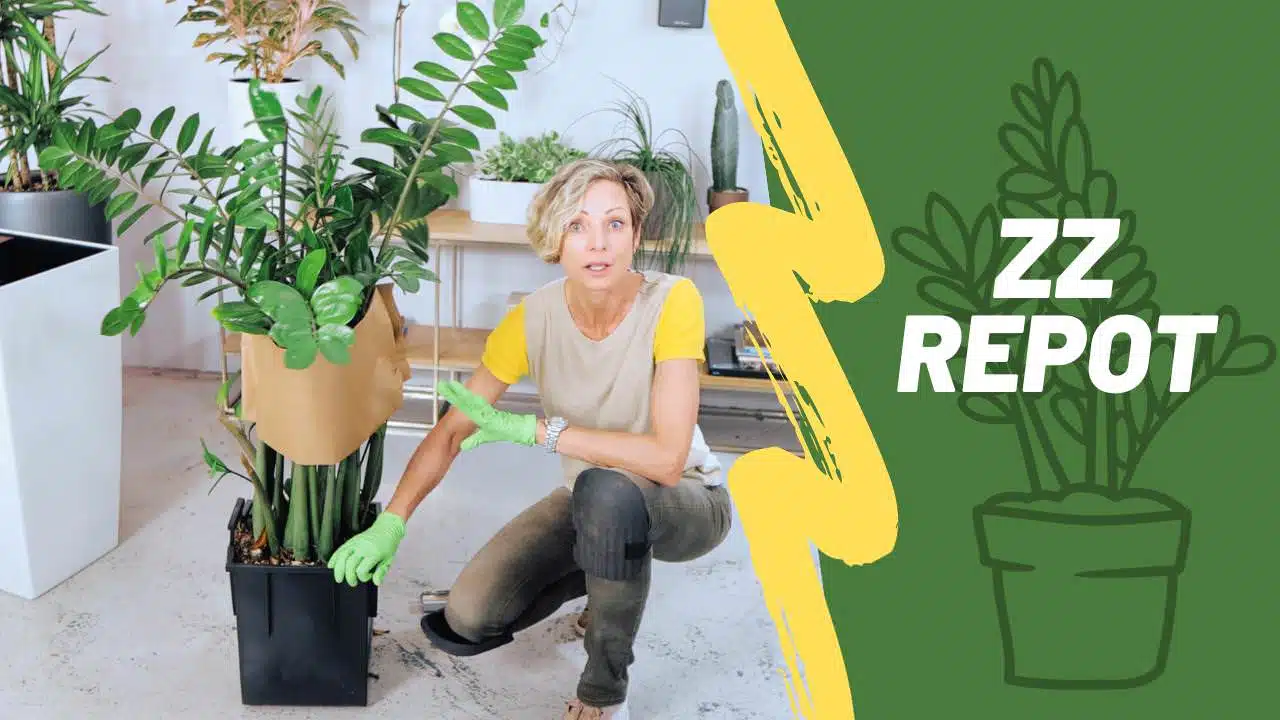
Excessive yellowing
When I notice excessive yellowing leaves on a ZZ plant, it can indicate various issues, including overwatering, underwatering, inadequate light, or nutrient deficiencies.
It’s essential to assess the plant’s care routine and environment to determine the cause accurately. Adjusting watering frequency, providing proper light exposure, and ensuring adequate nutrition can help address the yellowing leaves and promote overall plant health.
ZZ Plant Care: Seasonal Adjustments
In caring for my ZZ plant year-round, I adapt my routine to suit its changing needs with the seasons, ensuring it stays healthy and strong.
Here’s a summary of how I care for my ZZ plant during different seasons:
Spring
Watering: I increase watering as the plant enters its active growth phase.
Fertilizer: I begin feeding my plants in March and continue until the end of summer.
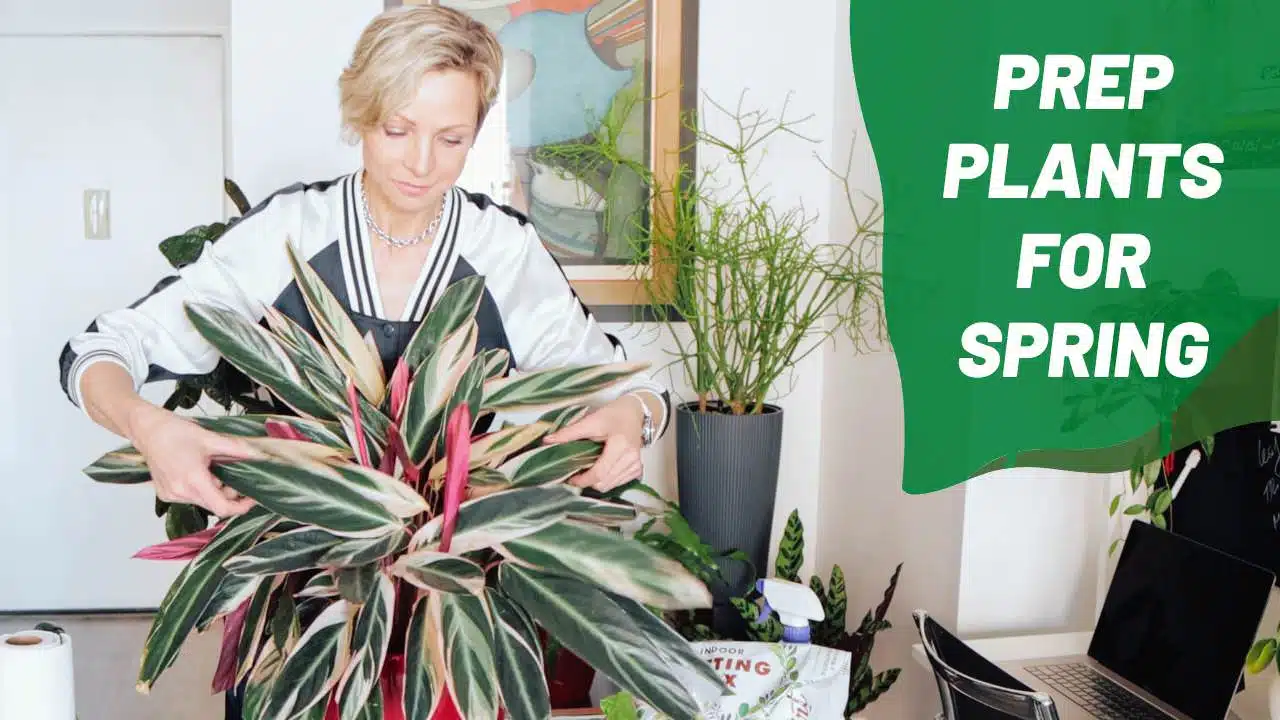
Learn more about spring plant care.
Summer
Watering: ZZ plants often need more frequent watering due to the warmer temperatures and longer daylight hours.
Outdoor: Plants can be taken outdoors during summer when temperatures are steady and above 60°F (15°C).
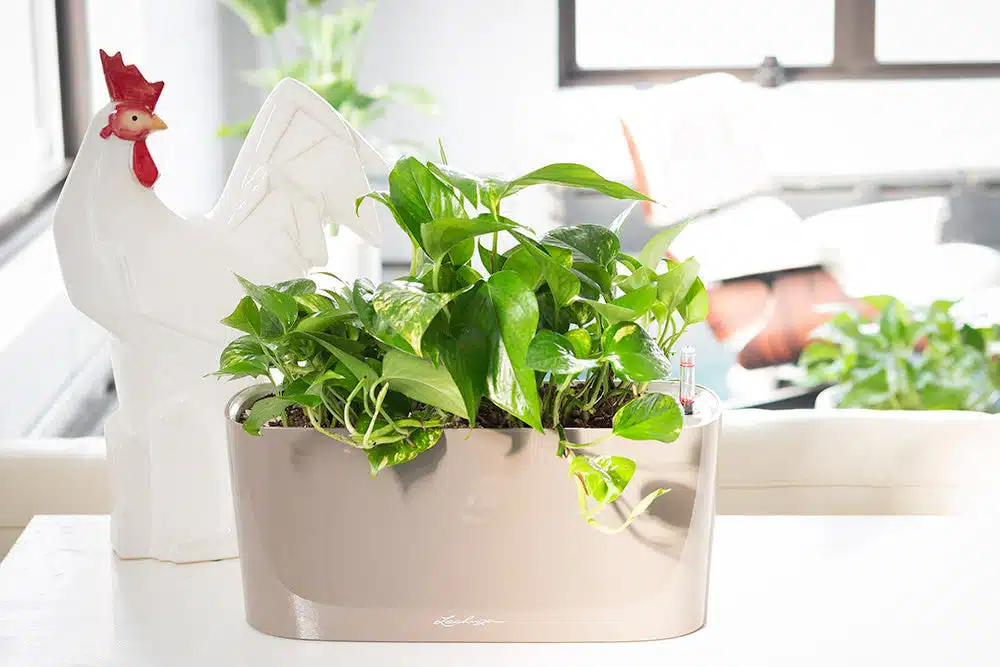
Learn more about summer plant care.
Fall
Watering: I reduce the frequency of watering as the plant’s growth slows.
Temperature: It’s crucial to ensure my ZZ plant is not in a space that could drop below 60°F (15°C).

Learn more about fall plant care.
Winter
Watering: I limit watering since the plant is semi-dormant, and overwatering can lead to root rot.
Light: With shorter days, I make sure my ZZ plant still receives enough light, often placing it near a bright window.

Learn more about winter plant care.
In all seasons, it’s important for me to ensure the plant is not exposed to drafts, heat, or sudden temperature changes. Regular observation helps me fine-tune care and keep my ZZ plant thriving throughout the year.
Growing a ZZ plant is a lesson in patience, but the wait is worth it. While it won’t sprout overnight, the resilience and hardiness of this plant make it a valuable addition to any green collection. With a little time and care, you’ll be rewarded with a beautiful and enduring companion in your indoor garden.
I can’t wait to hear about your ZZ plant journey—share your experiences or ask questions in the comments below!
ZZ Plant Care: FAQ
In this part, I’ll answer some common questions about caring for ZZ plants, giving straightforward and helpful answers based on proven plant care know-how.
Do ZZ plants like misting?
No, they don’t need misting. However, it’s important to regularly wash their leaves to remove dust.
Can I combine two ZZ plants into one pot?
Yes, you may combine two or more plants to create a larger arrangement. Just ensure that all plants fit nicely in the pot and leave some space around and under the roots to add soil.
My ZZ plant’s leaves are turning yellow. What should I do?
Yellowing can be the result of insufficient light, lack of nutrients, or improper watering.
Adjusting watering frequency, providing proper light exposure, and ensuring adequate nutrition can help address the yellowing leaves and promote overall plant health.
Is the ZZ plant poisonous?
ZZ plants contain saponins, which can cause skin irritation and are considered toxic to pets and humans if ingested. Always handle with care and keep away from animals and children.





